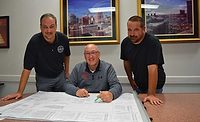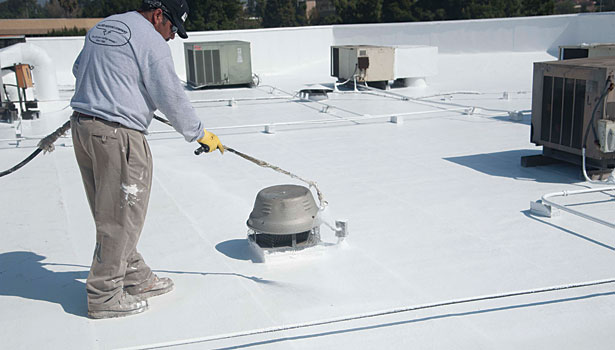Going the Extra Mile
At Allied Roofing Company, Hard Work Pays Off

Allied Roofing installs fluid-applied elastomeric roof coating from Polyglass on a roof with multiple penetrations. PG 700 elastomeric coating (ASTM D-6083) is ENERGY STAR® rated, UL Classified and FM Approved.



Jared Ewart believes Allied Roofing has a value proposition that pays off for its commercial clients and the company. His father, Wayne Ewart, founded the business in 1980, and it has always been a family affair. According to Jared Ewart, that’s a primary source of its strength. “Being family owned and operated, we’re devoted to our projects, and we’re devoted to the company,” he said. “We’re not here to sell you something and disappear the next day. We’re in it for the long haul. We’re going to be around. We’ve been around for 30 years, and we plan to be around for another 30 years.”
Based in Santa Ana, Calif., Allied Roofing focuses on commercial roofing and waterproofing. Ewart chalks up his company’s successful track record to understanding and meeting the needs of his clients and running a tight ship. He runs the business along with his mother, Karen Ewart, who does the financials. His sister Ashley handles marketing and is the project coordinator.
“We offer an extreme value,” Ewart said. “We don’t have a lot of overhead that’s wasting dollars. Those dollars are being passed on to the client. We have a business model that saves people money in the end.”
Up on the Roof
Ewart has been comfortable on a roof since he was five or six years old. “My dad would take me out and take me up on the roofs on Saturdays,” he said.
His father started roofing in Philadelphia and moved his family to California in the early 1970s. Allied Roofing was initially located in Santa Clarita. Ewart worked for his father’s company during summer vacations while still in high school. “I was the boss’s son, so I got all the dirty jobs,” he said. “I started at the bottom making $35 a day. I’d come home filthy dirty. I slowly worked my way up, bought a truck when I was 16, and by the time I was 17, I was working full time.”
He joined the business in 1990 right out of high school, running residential crews as a foreman during the day and eventually handling sales calls in the evening. Eventually he added responsibilities on the commercial side, taking over all of the company’s troubleshooting. “When there was a problem, my dad put me on it.” He said. “He knew I’d get it resolved. So I got really good at problem solving, fixing roof leaks. And that’s important. The problems are what can sink you, so you’ve got to handle those. You can’t let it fester.”
Business was booming in the ’80s and ’90s, driven by population growth in California and the 1994 Northridge earthquake. “It caused massive destruction through north L.A. County, the San Fernando Valley, even down into LA,” Ewart stated. “Freeway overpasses collapsed, shopping malls collapsed. It’s fortunate it happened in the early morning hours, or the death toll would have been astronomical.”
The company now handles some national accounts and has worked in Northern California and Montana, as well as Washington, D.C., Pittsburgh, Seattle and Las Vegas. The company even re-roofed a large shopping mall in Halifax, Nova Scotia.
When Ewart’s father passed away in 2008, Jared was ready to take the helm. “I knew the business well,” he said. “My father groomed me for this business. He had a head for it. He loved it. You couldn’t keep him away from it. If he was still alive, he’d still be sitting here in the office. He enjoyed it, and he was a hard worker.”
Satisfying Customers
Ewart credits his long-term employees as the key to providing quality workmanship. “There is integrity there,” he said. “It’s strong. We feel we owe it to our clients to give them the best service for the best value we can.”
According to Ewart, the first step is determining the client’s needs. “We’ll explain the roof coating systems, how it works, what’s involved, what the benefits are to it, the longevity, life expectancy, plans for the future,” he said. “Do they want to put a new roof on? Are they looking for a 20-year roof? We try to determine what they want and how much money they want to spend. Once we determine that, we make a recommendation based on what’s existing, and we’ll give them the options.”
He pointed to a recent re-roofing project for a long-term client as one example. It was an old office building that housed a law firm on the top floor, and multiple leaks in the existing built-up roof were causing constant problems. “The roof had some deterioration, failures at roof drains, punctures and tears, and damage from foot traffic,” Ewart said. “You had numerous rooftop mechanical units, satellite dishes, and people can be very destructive to a roof if they don’t pay attention.”
After some light maintenance and roof repairs, they decided the roof was in good enough shape to hold up, and they recommended a fluid-applied roof system from Polyglass USA, Inc. After installing a basecoat of asphalt emulsion reinforced with a layer of polyester, the roof was covered with two coats of PG 700 elastomeric roof coating.
Ewart noted that the system is an excellent option as long as the existing roof system allows it. The monolithic coating encapsulates the existing roof, and it’s ideal for roofs with numerous penetrations and hard-to-reach areas. “Even torch-applied systems have trouble getting into tight corners, but with a roof coating, you can spray that stuff into tight spaces, lay the polyester out, and spray around lots of penetrations. It works around everything,” he said. “It encapsulates everything and seals up the existing problems.”
According to Ewart, in this case installing the new roof was easy; it was fixing the leaks in the existing roof that was the hardest part. “We went the extra mile and made sure the client and the tenants were well taken care of,” he said.
Coatings are a big segment of the market in California, said Ewart, who acknowledges that Title 24 requirements pose some challenges for contractors even as they help the environment. “We’re using roof systems that are more friendly to the environment,” he said. “The roof coating systems — that’s a green roof. We’re not tearing off the roof. We’re not putting it in a landfill. Being forced to use these types of roof systems because of the laws is helping the environment — drastically. There are less pollutants, too. The roof coatings are waterborne products, so there are no VOCs.”
Training Never Stops
Ewart lauds his experienced crews and provides ongoing training to keep them up to date on safety requirements and new technology. Monthly safety training from an outside agency is complemented by weekly tailgate meetings and daily safety checklists. Employees also receive training on all types of installation and systems, and the company and its manufacturer partners provide the tools and training they need to do the job right. “We don’t make them improvise,” Ewart said. “If they need the right piece of equipment, they get it. And they get the training to use it.”
“The most satisfying part is just knowing the client is happy,” Ewart said. “When the rain comes, they aren’t calling me about a problem. They are calling me because they have another roof project. That’s what I live for with this business.”
Looking for a reprint of this article?
From high-res PDFs to custom plaques, order your copy today!






